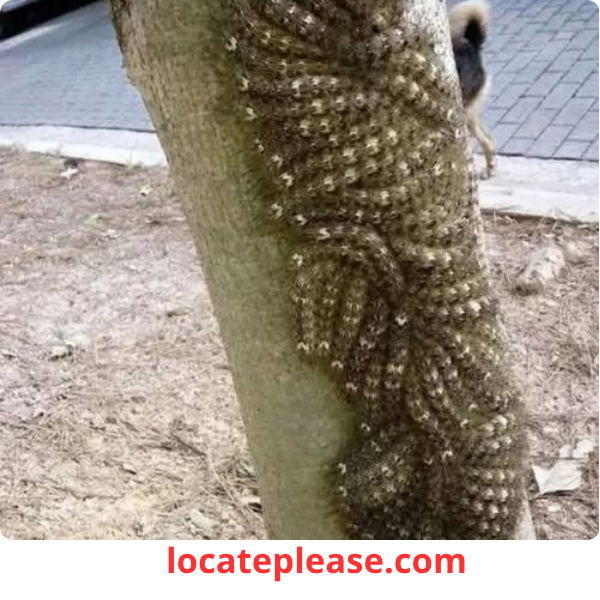It was a perfect afternoon — golden sunlight dappled through the trees, birds chirped in the distance, and our children ran barefoot across the grass, laughing with pure, unfiltered joy. We’d found a quiet spot in the woods for a family picnic, far from the main trail, nestled in a peaceful grove.
Everything felt serene.
Until it wasn’t.
Our 6-year-old daughter, always drawn to the wonders of nature, suddenly called out,
“Mom! Dad! Come see! This tree has stripes — it looks so pretty!”
We turned to see her, wide-eyed and enchanted, inching closer to the trunk. Her tiny hand reached out, fingers stretching toward what she thought was a natural pattern on the bark.
And then —
My husband moved like lightning.
In one swift motion, he lunged forward, scooped her up, and pulled her back.
Her hand had been inches away from something that could have taken her life.
What We Saw Next Still Gives Me Chills
At first glance, the “stripes” on the tree looked like moss, lichen, or some kind of natural bark texture.
But as we looked closer — heart pounding — we realized it was a cluster of soft, hairy caterpillars, tightly packed together, perfectly camouflaged against the tree.
We later learned their name:
👉 Lonomia obliqua — one of the most venomous caterpillars in the world.
Native to South America, particularly Brazil, these caterpillars are masters of disguise.
Their delicate, fern-like spines blend seamlessly with tree bark — making them nearly invisible to the untrained eye.
And a single touch can be deadly.
Why Lonomia Caterpillars Are So Dangerous
These small, fuzzy creatures may look harmless — even beautiful — but they carry a potent neurotoxic venom in their spines.
When touched, the spines break off and inject venom into the skin, triggering a terrifying chain reaction:
⚠️ Symptoms can include:
- Intense burning pain at the site
- Swelling and redness
- Headache, nausea, and vomiting
- Internal bleeding (due to uncontrolled anticoagulation)
- Kidney failure
- Hemorrhagic stroke
- Death — within 48 hours, if untreated
Even more alarming:
👉 Just one caterpillar can deliver enough venom to cause life-threatening complications.
👉 Children are at highest risk — their smaller bodies react more severely.
There is an antivenom, but it must be administered immediately — and it’s not always available in remote areas.
A Miracle — And a Warning
Thanks to my husband’s quick instincts, our daughter was unharmed.
We immediately called local environmental authorities, who confirmed the presence of Lonomia caterpillars.
They carefully removed the colony and placed a warning sign on the tree to protect other families.
But that moment changed everything for us.
Now, every time we step into nature, I carry:
- Gloves (for the kids and me)
- A magnifying glass (to inspect before touching)
- A basic first aid kit
- My phone — charged and ready to call for help
This isn’t about fear.
It’s about respect, awareness, and responsibility.
A Heartfelt Message to Parents and Grandparents
To every mom, dad, grandma, and grandpa who loves taking their kids into the woods, parks, or trails:
Please talk to your children about the invisible dangers in nature.
You teach them not to talk to strangers.
Teach them not to touch strange-looking plants or insects — no matter how “pretty” they seem.
Have this conversation:
“Some bugs and plants look harmless, but they can hurt you. Always ask an adult before touching anything in the wild.”
It takes two minutes.
It could save a life.
How to Stay Safe in Nature
✅ Never touch unknown insects, plants, or growths on trees
✅ Teach children to “look, don’t touch”
✅ Wear long sleeves and gloves when hiking in wooded areas
✅ If you see a fuzzy cluster on a tree — assume it’s dangerous
✅ Call local wildlife or park authorities immediately
One phone call could prevent another family from facing what we nearly did.
Final Thoughts: Nature Is Beautiful — But Demands Respect
We love the outdoors.
We want our children to grow up with dirt under their nails and wonder in their hearts.
But nature isn’t just gentle breezes and blooming flowers.
It also holds hidden dangers — silent, still, and deadly.
That day, our daughter’s curiosity was met with love, protection, and a lesson she’ll never forget.
And now, I share our story — not to scare, but to warn, to prepare, and to protect.
Because in the wild,
a single touch can change everything.
Look closely. Stay back. Speak up. One moment of caution can last a lifetime.










